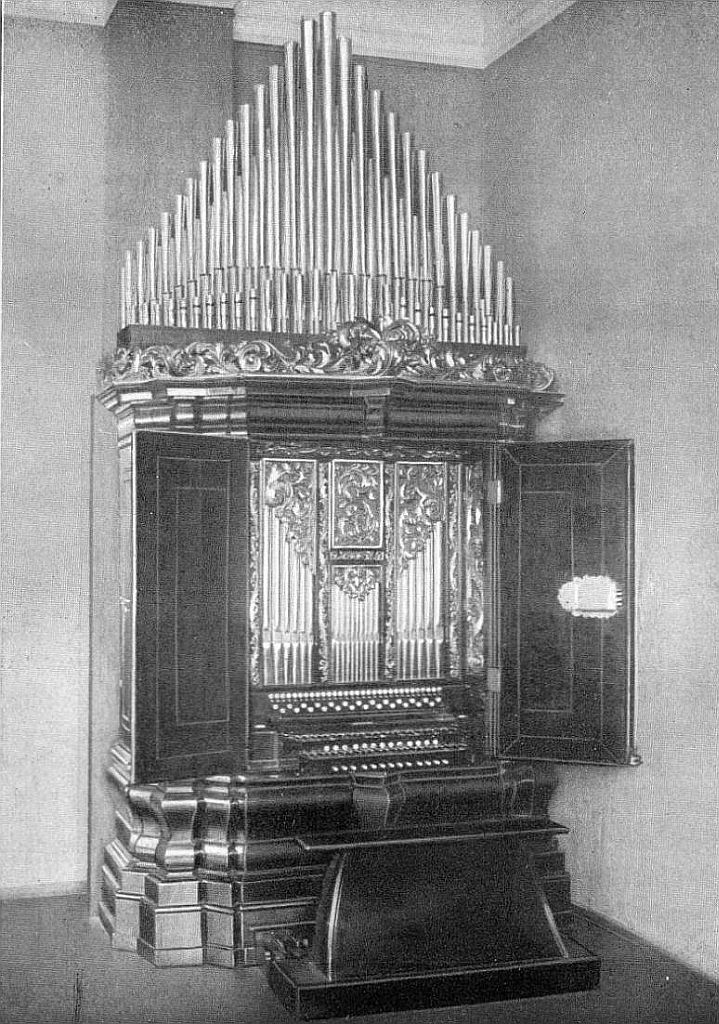Volledige beschrijving geselecteerd orgel

Foto: Steinmeyer Orgelbau
Oberschongau, Die Schweiz / La Suisse (Luzern) - Wallfahrtskirche Oberschongau
Gemeente: Schongau
Adres: Oberschongauerstrasse, 6288, Schongau
Beschrijving nr.: 2033731.
Gebouwd door: Orgelbau Kuhn AG (1964)
Kort overzicht van plaatsen waar het orgel heeft gestaan
Technische gegevens
Dispositie
Manual (C-g''', deling tussen b°/c'): Gedackt 8' (B/D), Principal 4' (B/D), Rohrflöte 4' (B/D), Octävlein 2' (B/D), Larigot 1 1/3' (B/D), Scharf 3-4 fach (1') (B/D).

Foto: Steinmeyer Orgelbau
Oberschongau, Die Schweiz / La Suisse (Luzern) - Wallfahrtskirche Oberschongau
Gemeente: Schongau
Adres: Oberschongauerstrasse, 6288, Schongau
Beschrijving nr.: 2033731.
Gebouwd door: Orgelbau Kuhn AG (1964)
| Jaar | Orgelbouwer | Opus | Activiteit | 1685 | David Jacob Weidner | nieuwbouw | 1900 | Orgelbauwerkstatt März | overplaatsing | 1901 | Orgelbauwerkstatt März | ombouw | 1909 | G.F. Steinmeyer und Co. | 1040 | nieuwbouw in bestaande kas | 1964 | Orgelbau Kuhn AG | nieuwbouw in bestaande kas |
- In 1910 voltooide G.F. Steinmeyer & Co. als opus 1040 een salonorgel voor de Musiksalon van Dr. Graf Felix von Saëdt, geheime kamerheer van de paus en woonachtig in München. Het oude front, dat de kern vormde van de voorkant van het salonorgel, werd in 1898 door Von Saëdt verworven. Het was een oud positief met vier registers, afkomstig uit de Marienkapelle van de Dom in Augsburg, dat in 1685 was gebouwd door David Jacob Weidner. De orgelbouwer Max Maerz (München) repareerde het en plaatste het in 1900 in de salon van Von Saëdt.
- Al snel was hij niet tevreden met de klank van het instrument. In 1901 vernieuwde Maerz het orgel volledig en breidde het uit tot achttien registers op twee manualen, met mechanische kegelladen. Twee prominenten gaven het eerste concert: de organist Karl Straube, op viool begeleid door de schilder Paul Klee.
- In 1908-1910 volgde een verdere ombouw, nu door Steinmeyer, met pneumatische Taschenladen. Adviseur was Emile Rupp. Het orgel werd in de tijd vóór de Eerste Wereldoorlog een bekend instrument voor de internationale orgelscène: Charles-Marie Widor en Albert Schweitzer bespeelden het. In 1918 moest Von Saëdt zijn huis in München verlaten. Hij schonk het orgel aan een collega-priester in het klooster Engelberg, waar het in 1920 werd ingewijd. De verhuizing deed het orgel geen goed. In 1945 werd het buiten gebruik gesteld en gesloopt. In het klooster werd de historische Augsburgse orgelkas opgeslagen.
- In 1964 werd deze door Kuhn voorzien van een nieuw interieur met zes registers. en geplaatst in de Wallfahrtskirche Ober-Schongau (LU).
Kort overzicht van plaatsen waar het orgel heeft gestaan
| 1685 | Augsburg | Hohe Domkirche Sankt Maria, Marienkapelle |
| 1898 | München | Felix von Saedt residence |
| 1920 | Engelberg | Benediktinerkloster (Abtei) |
| 1961 | Oberschongau | Wallfahrtskirche |
Technische gegevens
| Aantal registers per werk | |
| - Manual | 6 |
| Totaal aantal stemmen | 6 |
| Toetstractuur | Mechanisch |
| Registertractuur | Mechanisch |
| Windlade(n) | Sleepladen |
Dispositie
Manual (C-g''', deling tussen b°/c'): Gedackt 8' (B/D), Principal 4' (B/D), Rohrflöte 4' (B/D), Octävlein 2' (B/D), Larigot 1 1/3' (B/D), Scharf 3-4 fach (1') (B/D).
| Overige dispositiegegevens | |
|---|---|
| Verschillende disposities |
De dispositie van het Steinmeyer-orgel uit 1910 luidde: I. Manual (C-g'''): Principal 8', Bourdon 8', Dolce 8', Oktav 4', Rohrflöte 4', Sifflöte 2', Superquinte 1 1/3', Mixtur 4 fach (2'), Clarinette 8', Tremolo. Im Schweller: Lieblich Gedeckt 16', Soloflöte 8', Unda maris 8', Quintatön 8', Cornett 2-6 fach (8'). Im besonderen Schweller: Vox Humana 8', Tremolo für Vox Humana. II. Manual (im Schweller) (C-g'''): Doppelgedeckt 8', Echobourdon 8', Viola di Gamba 8', Vox Coelestis 8', Principal 4', Flûte d'Amour 4', Piccolo 2', Larigot 2 fach (2'), Cimbel 3 fach (1'), Trompete 8', Tremolo. Pedal (im Schweller) (C-d'): Subbaß 16', Gedecktbaß 16' - transmissie, Violoncello 8'. Couplers: I. Manual - II. Manual, Pedal - I. Manual, Pedal - II. Manual, I. Manual - II. Manual Sub, I. Manual - II. Manual Super, II. Manual - II. Manual Sub, II. Manual - II. Manual Super. Accessories: 1 freie Kombination, Tutti, Generalcrescendo. |
| Links |
https://www.orgelbau.ch/op=110770 http://peter-fasler.magix.net/public/LUProfile4/lu_schongau_wallfahrt.htm |
